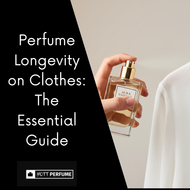Perfume Longevity on Clothes: The Essential Guide
Posted by Tina Wilson on Nov 20th 2025

Introduction to Perfume
The longevity of perfume on clothes, or how long perfume lasts, depends on several factors, including the fragrance concentration, the type of fabric, and environmental conditions. Understanding these elements can help you make your favorite scents last longer.
Different types of perfumes, such as eau de parfum, eau de toilette, and eau de cologne, influence how long perfume lasts on fabrics, affecting how long their aroma lingers. While applying perfume to clothes can leave a lasting fragrance, it’s important to consider fabric type to avoid potential staining.
Perfume Types and Longevity
The fundamental longevity of any fragrance is dictated by the ratio of perfume oil to alcohol and the molecular weight of its ingredients.
A. Fragrance Concentration
The higher the concentration of perfume oils, the longer the scent will adhere to clothing fibers.
-
Parfum (Pure Perfume): Features the highest concentration of essential oils. This is the longest-lasting form, capable of clinging to heavier fabrics like wool or denim for days or even weeks.
-
Eau de Parfum (EDP): The most common choice for daily longevity. It provides a rich scent that typically remains noticeable on clothes for 24 hours or more.
-
Eau de Toilette (EDT) / Eau de Cologne (EDC): Contains the lowest oil concentration, offering a lighter aroma that fades more quickly, usually lasting from 6 to 12 hours on fabric.
B. The Role of Notes
Perfumes are blended in a 'pyramid' of fragrance notes that evaporate at different speeds:
-
Top Notes (e.g., citrus): Evaporate quickly and are the first to fade from the fabric.
-
Middle/Heart Notes (e.g., floral, spice): Form the core of the scent and provide moderate longevity.
-
Base Notes (e.g., musk, vanilla, woods): These large, heavy molecules evaporate slowly. Fragrances rich in base notes are the key to enduring scent on clothes, often lingering long after the lighter notes have vanished.

Applying Perfume for Optimal Longevity
To get the maximum performance from your fragrance and ensure its scent endures on both you and your clothes, use these professional layering and application techniques:
-
Target Your Base (Skin): Apply perfume to warm pulse points (wrists, neck, inner elbows). Crucially, apply it to moisturized skin (using unscented or matching lotion), as scent molecules bind more effectively to hydrated skin than to dry skin.
-
Layering for Strength: Use a matching scented body wash or lotion to create a foundational layer. Scent layering helps anchor the fragrance, boosting its overall intensity and ensuring a seamless scent experience.
-
Mist Your Fabric: Once the perfume has dried on your skin, lightly mist your clothing from a distance. The scent will cling to the fabric fibers, lasting long after it has faded from your body.
-
Use Hair as a Diffuser: Spraying perfume onto a brush and running it through your hair (which is also porous) can help diffuse the scent gradually throughout the day without damaging delicate hair.
-
Caution with Delicates: Always perform a patch test on delicate or light-colored fabrics (especially silks and satins) before spraying directly, as the oil and alcohol content can cause irreversible staining or discoloration.
Mastering the Art of the Perfume Note: A Comprehensive Guide
Factors Affecting Perfume Longevity
Several intertwined factors determine exactly how long a scent will anchor to your garments and maintain its presence:
-
Fabric Type (The Anchor): Natural fibers like wool and cotton are porous and fibrous, allowing them to absorb and trap scent molecules deep within their structure. They retain fragrance significantly longer, often for days, than smooth, tightly woven, or synthetic materials.
-
Fabric Fixatives & Concentration: Fragrances with a higher concentration of perfume oils (Parfum or EDP) naturally contain more fixatives (heavy base notes) that resist evaporation, providing a prolonged lifespan on the fibers.
-
Environmental Conditions (The Evaporation Rate): High temperatures and direct sunlight accelerate the evaporation rate of fragrance molecules from both skin and fabric. Conversely, perfumes linger far longer on clothes in cooler, darker, and low-airflow environments (like a closet).
-
Air Flow: Constant exposure to wind or high air circulation accelerates the dissipation of scent molecules, reducing how long the fragrance lingers, especially on outerwear.
-
Note: We focus on cloth longevity, but remember that Body Heat and Skin Type are why perfume fades faster on skin. The fabric is the solution to these issues.
Environmental Conditions and Perfume
You can significantly boost the longevity of perfume on your garments by controlling their environment and considering environmental factors. Evaporation is the enemy of a long-lasting scent.
-
Avoid Heat and Sunlight (The Accelerator): Do not expose perfumed clothes to direct sunlight or high heat. These conditions dramatically accelerate the evaporation of the scent molecules and can also degrade the quality of the perfume oils themselves.
-
Seek Cool and Dark (The Preserver): Perfume lasts longest when garments are stored in a cool, dark, and low-airflow environment (such as a closed wardrobe). Cooler temperatures slow the molecular movement, helping the scent cling to the fibers for days.
-
Tip for Odor Removal: If you need to neutralize a lingering scent, avoid aggressive washing. Instead, use a simple soak in water with a cup of baking soda or an overnight airing-out session, as baking soda is highly effective at absorbing unwanted odors from fabric.
Making Perfume Last Longer
The power of a fragrance is not just in its scent, but in its persistence, which contributes to a long-lasting scent profile. By understanding the interaction between perfume chemistry and fabric fibers, you can master the art of scent longevity.
The Takeaway: The key to long-lasting scent is moving the fragrance application from transient skin to stable fabric.
To maximize the lifespan of your favorite perfume on your clothes:
-
Choose Wisely: Opt for Eau de Parfum (EDP) or Parfum concentrations, which contain a higher percentage of long-lasting base notes (like woods and musk).
-
Layer Your Scent: Boost perfume longevity by using complementary scented body lotions or body oils as a base before applying the fragrance.
-
Target the Right Fabric: Apply to porous, natural fibers like cotton and wool, which hold scent molecules better than synthetics.
-
Mind the Care: Avoid washing garments in hot water or with harsh detergents, as these rapidly strip the perfume molecules from the fibers.
By applying these strategies, your signature scent will not only last throughout the day but will also subtly linger on your wardrobe, turning your clothing into a constant source of aromatic pleasure.
Clothes and Perfume
Different fabrics, especially natural fabrics, absorb and retain perfume scents in varying ways. Natural fibers like cotton, wool, and silk generally hold fragrance longer than synthetic materials, which may repel or quickly lose scent.
When applying perfume to clothes, consider the fabric type to maximize longevity and avoid damage. Delicate fabrics, such as silk or lace, require special care to prevent staining or discoloration.
Using spray perfumes or fabric-specific fragrance sprays can help distribute scent evenly across the fabric, reducing the risk of concentrated spots that might cause stains.
Complementary Products for Longevity
Enhance the longevity of your perfume by using scented body lotions or essential oils that match your favorite fragrance. These complementary products help create a cohesive scent profile and lock in the aroma for longer.
Applying perfumes like eau de parfum to pulse points on your skin and layering with matching lotions or oils can significantly extend the fragrance’s presence throughout the day.
Additionally, using a perfume primer, a product designed to prepare your skin for fragrance, can further boost the lasting power of your favorite scents.
Perfume Concentration and Longevity
The concentration of high-quality perfume oils is a major factor in determining how long a fragrance lasts on fabric, but the type of notes used determines its final resilience.
|
Concentration Level |
Oil Content |
Longevity Implication |
|
Perfume (Pure Perfume) |
Highest (20% - 30%) |
Most Enduring Choice. Designed to last for days on clothing fibers. |
|
High (15% - 20%) |
Excellent Longevity. Typically remains noticeable for 24+ hours on fabric. |
|
|
Eau de Toilette (EDT) / Eau de Cologne (EDC) |
Low (2% - 15%) |
Lightest Longevity. Ideal for quick refreshment, fades within a day. |
The Role of Notes: For maximum longevity, choose fragrances dominated by base notes (such as musk, vanilla, amber, or woods). These are the heaviest molecules and act as natural "fixatives," anchoring the scent to the fabric long after the lighter, volatile top notes have evaporated.
Mastering Perfume: A Practical Guide to Fragrance Types
Storage and Handling of Perfume
The way you store your perfume bottle directly impacts its chemical composition and, consequently, how long the scent will last on your skin and clothes. Heat, light, and air are the enemies of fragrance longevity.
-
Don't Store in the Bathroom: Never keep perfumes in areas with fluctuating temperature and high humidity, like the bathroom. This rapid environmental change degrades the oil compounds and shortens the scent's life.
-
Store Cool and Dark: To preserve the fragrance's integrity and vibrancy for years, store it in a cool, dark place, ideally within its original box, drawer, or dedicated wardrobe space.
-
Handling Tip: Always ensure the cap is tightly secured. Frequent exposure to air (oxidation) breaks down the delicate molecules, leading to a duller scent that fades more quickly upon application.
Removing Perfume Scent from Clothes
If the perfume scent on your clothes becomes too strong or overwhelming, there are several effective methods to neutralize it.
- A gentle baking soda solution or white vinegar can help remove excess fragrance without damaging the fabric.
- Activated charcoal is another option, as it naturally absorbs lingering scents from fabrics over time.
- For delicate garments or stubborn perfume stains, professional cleaning may be necessary to ensure the fabric is treated safely.
- Avoid using harsh detergents or washing clothes in hot water, as these can cause the perfume to fade unevenly or even lead to staining.
Balancing Longevity and Flexibility
Striking the right balance between perfume longevity and flexibility is key to enjoying your fragrance without overwhelming others or risking stains on your clothes.
Consider the fabric type and the concentration of perfume oils, as multiple factors affect how the scent is retained when applying scent to garments. Natural fibers tend to hold fragrance longer, so apply with care.
Using complementary products like scented lotions and fabric softeners can enhance longevity while allowing for a more subtle scent profile. Applying perfume strategically to pulse points on your skin and using fabric sprays can help distribute fragrance evenly, ensuring a pleasant and lasting aroma.
Applying Perfume to Skin and Clothes
To create a lasting fragrance, apply perfume to pulse points on your skin such as wrists, neck, and behind the ears, where warmth helps release the scent throughout the day. Additionally, spraying perfume on clothes can extend the scent’s longevity.
Complement your perfume with scented body lotions or oils to enhance and layer the fragrance for a richer, longer-lasting effect. Focus on fabrics that hold scent well, like natural fibers, when applying perfume to clothes to maximize how long the fragrance lasts. Avoid rubbing perfume into your skin, as this can break down the fragrance molecules and cause the scent to fade more quickly.
Conclusion
The lasting power of perfume on clothes depends on various factors, including how long perfume will last based on the type of fragrance, fabric, and environmental conditions. By understanding these elements and applying perfume thoughtfully, whether on skin or fabric, you can enjoy your favorite scents for longer.
Using complementary products, choosing high-quality perfumes, and storing them properly all contribute to maximizing fragrance longevity. With the right care and techniques, your perfume can leave a lasting, elegant impression wherever you go.

